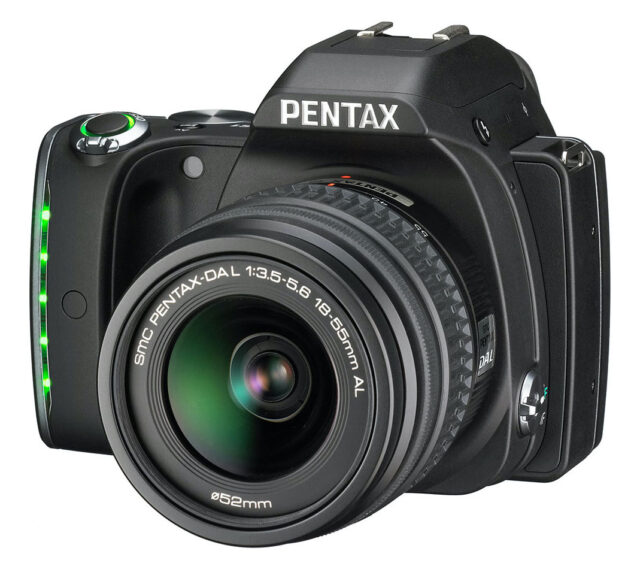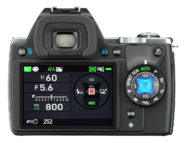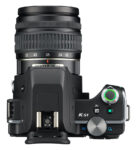Announced
Production status
System
Pentax K APS-C system cameras
- Pentax *ist D
- Pentax *ist DL
- Pentax *ist DL2
- Pentax *ist DS
- Pentax *ist DS2
- Pentax K-3
- Pentax K-3 II
- Pentax K-3 III
- Pentax K-3 III Monochrome
- Pentax K-30
- Pentax K-5
- Pentax K-5 II
- Pentax K-5 IIs
- Pentax K-50
- Pentax K-500
- Pentax K-7
- Pentax K-70
- Pentax K-m
- Pentax K-r
- Pentax K-S1
- Pentax K-S2
- Pentax K-x
- Pentax K100D
- Pentax K100D Super
- Pentax K10D
- Pentax K110D
- Pentax K200D
- Pentax K20D
- Pentax KF
- Pentax KP
Pentax K-S1
APS-C AF digital SLR camera • Discontinued
Specification
| Format: | |
| APS-C | |
Imaging sensor: | 23.5 × 15.6mm CMOS sensor |
Resolution: | 5472 × 3648 - 20 MP |
Crop factor: | 1.53x |
Sensor-shift image stabilization: | Yes |
| Pentax K [45.5mm] | |
| Shutter: | |
Type: | Focal-plane |
Model: | Electronically controlled |
Speeds: | 30 - 1/6000 + B |
| Exposure: | |
Exposure metering: | Through-the-lens (TTL), open-aperture |
Exposure modes: | Programmed Auto |
| Aperture-priority Auto | |
| Shutter-priority Auto | |
| Manual | |
| Physical characteristics: | |
Weight: | 498g |
Dimensions: | 120x92.5x69.5mm |
Manufacturer description #1
Denver, Colorado August 27, 2014 – Focused on expanding the number of PENTAX DSLR owners, RICOH IMAGING AMERICAS CORPORATION is excited to announce the launch of the PENTAX K-S1 DSLR camera. By combining proven imaging technology, distinct design cues and a flat field user interface (UI) the K-S1 appeals to the next generation PENTAX owner without surrendering the performance expected in a mid-class camera.
Building on the many technologies benchmarked in the company’s popular K-3 advanced DSLR; the K-S1 incorporates a newly designed 20 megapixel image sensor, super-high sensitivity ISO 51200. In addition this model contains in-body shake reduction, an AA filter simulator, 100% field of view glass pentaprism viewfinder, and 5.4 frames per second shooting at a fast 1/6000 shutter speed. Adding to the user experience is the camera’s unique flat field user interface, which integrates a back-lit LED selection dial, four-way navigation, and a bright 3" 921,000 dot LCD that breaks tradition of the knobs and buttons found on traditional DSLR cameras.
The PENTAX K-S1 is designed to attract a mid-level customer who is accustomed to a mobile interface and is looking for a similar interaction in a DSLR. The simple UI eliminates many of the complexities of a DSLR and provides immediate feedback including shooting parameters, filter selection and effect modes, even in total darkness. The camera’s power switch, mode dial, OK button and grip all feature LED illumination; each of which indicates the current status of camera operation. This intuitive UI and design combined with category leading technology delivers a powerful imaging engine that is simple to use.
"With the K-S1 we are building on our solid reputation as a camera company and inviting new customers to experience the PENTAX advantage" said Jim Malcolm, Executive Vice President, Ricoh Imaging Americas Corporation. "Our core PENTAX products provide an important foundation that the K-S1 builds upon."
The optional Flucard for PENTAX offers additional features such as Wi-Fi transfer, wireless live view, and Remote Capture control; letting users take control of their camera settings with a smartphone, tablet, or computer and save images directly to a mobile device.
The K-S1 comes in 3 standard colors: black, blue, and white. In addition, two separate color collections are available; The Fabric Collection, containing 4 unique colors such as cotton beige and tweed gray – and the Night Sky Collection, with 5 more elegant colors like Sunset Orange, Dawn Purple, and Midnight Black.
Manufacturer description #2
2014.08.28 - RICOH IMAGING COMPANY, LTD. is pleased to announce the launch of the PENTAX K-S1 digital SLR camera. This standard-class model incorporates new elements that optimize digital taste, such as a progressive design and an innovative interface system, while providing outstanding imaging performance -- one that rivals even high-end models.
The PENTAX K-S1 is designed for users who have become familiar with taking photo through the use of their smartphones and tablet computers, but, because they are not totally satisfied with the image quality and features provided by those portable gadgets, have become interested in more serious photography. The K-S1 features a compact, progressive body design that overturns conventional concepts of digital SLR cameras, and an innovative Body Illumination interface system that facilitates intuitive camera operation. It also provides other outstanding features rivaling those of high-end models, including: the PENTAX-developed AA (anti-aliasing) filter simulator first installed on the PENTAX K-3 (launched in November 2013); an optical viewfinder with a glass pentaprism to provide approximately 100% field of view; an in-body shake reduction mechanism; and a top sensitivity of ISO 51200. These features combine to provide the exceptional digital imaging performance that will satisfy photographers of all levels -- from first-time SLR users to experienced photo enthusiasts.
Main Features
1. Body Illumination interface for intuitive camera operation
The PENTAX K-S1's power switch, mode dial, OK button and grip all feature LED body illumination, each of which indicates the current status of camera operation. The LEDs for the power switch, for instance, stay green during still-image shooting, but change color to red during movie recording. When the Face Detection function is activated, the number of LEDs illuminated on the grip corresponds with the number of faces that has been detected. These LED body illumination give a decorative illumination to the choice of distinctive body colors, furthering the look of the camera as a sophisticated digital device.
2. Compact, lightweight body with distinctive design
The K-S1 camera body's main chassis, including the grip, is designed to be compact in size and sophisticated in appearance, while its optics including the pentaprism employ solid, time-proven designs that easily match those of high-grade SLR cameras. By harmonizing these dissimilar elements, the K-S1 delivers a body design that is totally original and remarkably fashionable.
Note: This product design was developed in collaboration with and under supervision for design and color of Ziba Tokyo, Co., Ltd., the Tokyo branch of a design consultant firm Ziba, headquartered in Portland, Oregon, USA, and with other branches in Munich and San Diego.
3. High-resolution images produced by an image sensor with approximately 20.12 effective megapixels and a super-high sensitivity of ISO51200
The K-S1 is equipped with a newly developed CMOS image sensor with approximately 20.12 effective megapixels to deliver super-high-resolution images. It is also designed without an optical AA (anti-aliasing) filter to optimize the imaging power of the image sensor. By coupling this image sensor with the high-performance PRIME MII imaging engine, the K-S1 delivers true-to-life, fine-gradation images by effectively minimizing noise at all sensitivity levels, even during super-high-sensitivity shooting at ISO 51200.
4. In-body shake reduction (SR) mechanism, and AA (anti-aliasing) filter simulator for effective moiré reduction
(1) In-body SR (Shake Reduction) mechanism
The K-S1 features a PENTAX-developed SR (Shake Reduction) mechanism to effectively minimize camera shake and assure sharp, blur-free images, even in camera-shake-prone conditions such as when using a telephoto lens, shooting low-light scenes with incident light only, or photographing sunset scenes.
(2)Innovative AA (anti-aliasing) filter simulator*
By applying microscopic vibrations to the image sensor unit at the subpixel level during image exposure, the K-S1's AA filter simulator provides the same level of moiré-reduction effect as an optical AA filter. Unlike an optical AA filter, which always creates the same result, this innovative simulator lets the user not only switch the AA filter effect on and off, but also adjust the level of the effect, allowing the user to effortlessly apply the desired effect for a particular scene or subject.
(3) Supportive shooting functions
The K-S1's SR unit has a flexible design that tilts the image sensor unit in all direction, by shifting it horizontally (left/right) and vertically (up/down), and even rotating it. Taking advantage of this flexibility, the K-S1 provides a host of handy shooting functions, including ASTRO TRACER, which simplifies advanced astronomical photography in combination with the optional GPS unit,O-GPS1.
* This function is most effective with a shutter speed of 1/1000 second or slower. This function is not available during HDR (High Dynamic Range) shooting.
5. Optical viewfinder with approximately 100-percent field of view
Despite its standard-class classification, the K-S1 is equipped with a glass pentaprism finder featuring the same optics and coatings as those used in higher-level models. It assures the highest level of viewfinder brightness in its class, with a magnification of approximately 0.95 times to provide a broad image field for easy focusing and framing.
6. High-speed shutter to capture fast-moving subjects in crisp focus
The K-S1 provides a top shutter speed of 1/6000 second to assure sharply focused images, even with fast-moving subjects. Coupled with its high-speed continuous shooting function with a top speed of 5.4 images per second, it lets the photographer freeze once-in-a-lifetime shutter opportunities in beautifully focused images.
7. High-precision AF with SAFOX IXi+ AF sensor module
The K-S1 features the SAFOX IXi+ AF sensor module, which assures responsive, high-precision autofocus operation with 11 sensors, including nine cross-type sensors in the middle. It also provides a spot beam to assist AF operation in poorly lit locations. Its select-area expansion function ensures that the sensor module keeps tracking a moving subject, even when the subject moves out of a pre-assigned auto-tracking area, by assessing the distance data collected by neighboring focus sensors. The AF hold function maintains the in-focus position, even when the AF system loses track of the subject after once capturing it in focus. These functions combine to improve the camera's accuracy in the detection of moving subjects when its focus mode is set to AUTO, and upgrade its auto-tracking performance of these subjects when using a telephoto lens.
8. A selection of image-processing tools for creative, personalized expressions
Simply by setting the Mode dial to the EFFECT position, the user can apply the desired visual effect to an image while previewing the outcome on the LCD monitor. It provides a choice of 10 distinctive effects, including three new options: "Fresh" with a crystal-clean finishing touch; "Fade Color" for an elegant finish with subdued colors; and "Infrared" for a black-and-white finish like that of an infrared photo. The K-S1 also provides 21 digital filters (nine of them applicable during shooting), including a new "Color Replacement" filter.
9. Dependable lens aberration compensation system
In addition to the effective compensation of distortion, chromatic aberration and peripheral brightness, the K-S1 also provides a diffraction compensation function to effectively compensate diffraction, which deteriorates image resolution when the small aperture is used.
10. Smartphone-support functions**
By installing the optional FLUCARD FOR PENTAX 16GB memory card in the K-S1, the user can release the K-S1's shutter, check the live-view image, and browse and download the images recorded on the card using a smartphone.
** These functions support smartphones operating iOS6 or later and Android 4.2 or later.
11. 3.0-inch, high-resolution LCD monitor, and newly designed, easy-to-use GUI
On its back panel, the K-S1 features a high-resolution, wide-view LCD monitor with approximately 921,000 dots. It also provides a status screen employing the newly designed GUI (Graphical User Interface), which allows the user to confirm functions and settings assigned to the four-way controller and the OK button at a glance. The RICOH RT font has been used for on-screen menus to improve readability.
12. Full HD movie recording with stereo audio
The K-S1 captures beautiful Full HD movie clips (1920 x 1080 pixels; 30/25/24 frame rate) in the H.264 recording format, which assures flawless, high-quality movies even with fast-moving subjects. It is also equipped with a built-in stereo microphone for the recording of natural sound during Full HD movie recording.
13. Other features
- Compatible with Eye-Fi wireless LAN memory cards
- 77-segment, multi-pattern metering system for high-precision light measurement
- DR (Dust Removal) mechanism for effective elimination of dust on the image sensor using ultrasonic vibration
- Digital Camera Utility 5 software (latest version) included
Similar cameras (4)
APS-C • Auto focus • Digital • Singe-lens reflex • Pentax K mount
| Model | Shutter | Metering | Modes | Year |
|---|---|---|---|---|
| Samsung GX-10 | E, 1/4000 | TTL • OA | PASM | 2006 ● |
| Samsung GX-1L | E, 1/4000 | TTL • OA | PASM | 2006 ● |
| Samsung GX-1S | E, 1/4000 | TTL • OA | PASM | 2006 ● |
| Samsung GX-20 | E, 1/4000 | TTL • OA | PASM | 2008 ● |





